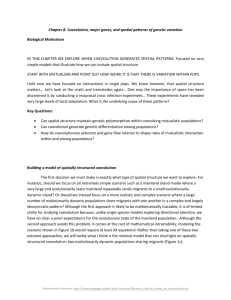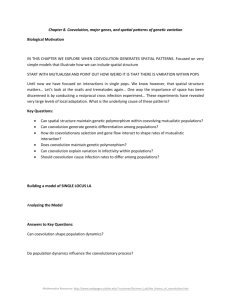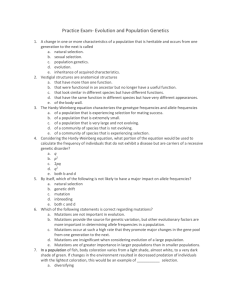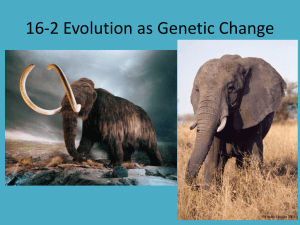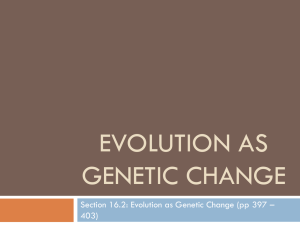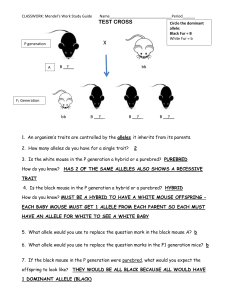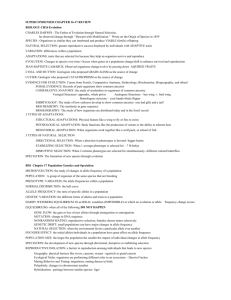Chapter 8. Coevolution, major genes, and spatial patterns of genetic
advertisement
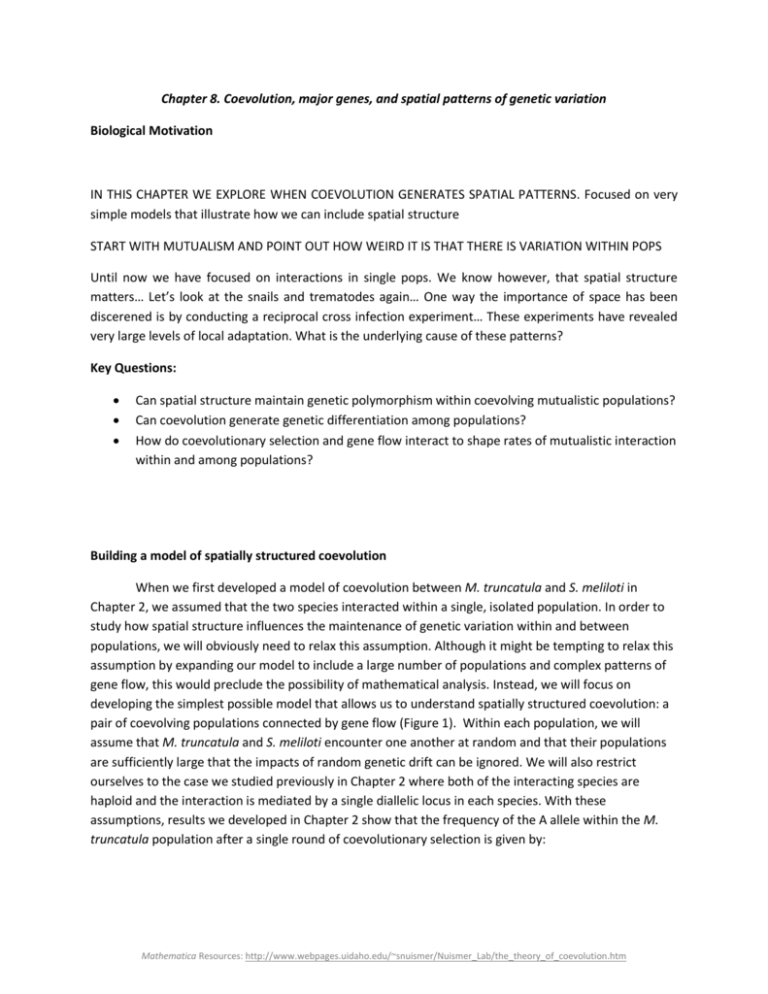
Chapter 8. Coevolution, major genes, and spatial patterns of genetic variation Biological Motivation IN THIS CHAPTER WE EXPLORE WHEN COEVOLUTION GENERATES SPATIAL PATTERNS. Focused on very simple models that illustrate how we can include spatial structure START WITH MUTUALISM AND POINT OUT HOW WEIRD IT IS THAT THERE IS VARIATION WITHIN POPS Until now we have focused on interactions in single pops. We know however, that spatial structure matters… Let’s look at the snails and trematodes again… One way the importance of space has been discerened is by conducting a reciprocal cross infection experiment… These experiments have revealed very large levels of local adaptation. What is the underlying cause of these patterns? Key Questions: Can spatial structure maintain genetic polymorphism within coevolving mutualistic populations? Can coevolution generate genetic differentiation among populations? How do coevolutionary selection and gene flow interact to shape rates of mutualistic interaction within and among populations? Building a model of spatially structured coevolution When we first developed a model of coevolution between M. truncatula and S. meliloti in Chapter 2, we assumed that the two species interacted within a single, isolated population. In order to study how spatial structure influences the maintenance of genetic variation within and between populations, we will obviously need to relax this assumption. Although it might be tempting to relax this assumption by expanding our model to include a large number of populations and complex patterns of gene flow, this would preclude the possibility of mathematical analysis. Instead, we will focus on developing the simplest possible model that allows us to understand spatially structured coevolution: a pair of coevolving populations connected by gene flow (Figure 1). Within each population, we will assume that M. truncatula and S. meliloti encounter one another at random and that their populations are sufficiently large that the impacts of random genetic drift can be ignored. We will also restrict ourselves to the case we studied previously in Chapter 2 where both of the interacting species are haploid and the interaction is mediated by a single diallelic locus in each species. With these assumptions, results we developed in Chapter 2 show that the frequency of the A allele within the M. truncatula population after a single round of coevolutionary selection is given by: Mathematica Resources: http://www.webpages.uidaho.edu/~snuismer/Nuismer_Lab/the_theory_of_coevolution.htm ′ 𝑝𝑋,𝑖 = 𝑝𝑋,𝑖 𝑊𝑋,𝐴,𝑖 ̅ 𝑋,𝑖 𝑊 (1a) and the frequency of the B allele within the S. meliloti population is given by: ′ 𝑝𝑌,𝑖 = 𝑝𝑌,𝑖 𝑊𝑌,𝐵,𝑖 ̅ 𝑌,𝑖 𝑊 (1b) where 𝑝𝑋,𝑖 is the frequency of the A allele in M. truncatula within population i, 𝑝𝑌,𝑖 is the frequency of the B allele in S. meliloti within population i, 𝑊𝑋,𝐴,𝑖 is the fitness of the A allele in population i, 𝑊𝑌,𝐵,𝑖 is ̅𝑋,𝑖 is the mean fitness of M. truncatula in population i, and the fitness of the B allele in population i, 𝑊 ̅𝑌,𝑖 is the mean fitness of S. meliloti in population i. Our next challenge in building our model of 𝑊 spatially structured coevolution is to figure out how gene flow between populations changes the frequencies of the A and B alleles. If we assume that individuals move between the two populations at random with a rate of mX in M. truncatula and mY in S. meliloti we can write down expressions for the allele frequencies within each population after gene flow occurs. The key to making progress is to focus on the proportion of each population that is made up of resident individuals (1-m) and the proportion of each population made up of immigrant individuals (m). Keeping this in mind, we can now calculate the allele frequency of each species within each population after gene flow occurs by calculating the weighted average allele frequency of residents and immigrants: ′′ ′ ′ (1 − 𝑚𝑋 ) + 𝑝𝑋,𝑗 (𝑚𝑋 ) 𝑝𝑋,𝑖 = 𝑝𝑋,𝑖 (2a) ′′ ′ ′ (1 − 𝑚𝑌 ) + 𝑝𝑌,𝑗 (𝑚𝑌 ) 𝑝𝑌,𝑖 = 𝑝𝑌,𝑖 (2b) where the double prime notation indicates the frequency of the allele after both selection and migration. In equations (2) the first term indicates the contribution to allele frequency within population i made by individuals that did not leave and the second term indicates the contribution made by individuals that arrived as immigrants from population j. Substituting (1) into (2) yields expressions for the allele frequencies of each species within each population in the next generation: ′′ 𝑝𝑋,𝑖 = 𝑝𝑋,𝑖 𝑊𝑋,𝐴,𝑖 (1 − ̅ 𝑋,𝑖 𝑊 𝑚𝑋 ) + 𝑝𝑋,𝑗 𝑊𝑋,𝐴,𝑗 (𝑚𝑋 ) ̅ 𝑋,𝑗 𝑊 (3a) ′′ 𝑝𝑌,𝑖 = 𝑝𝑌,𝑖 𝑊𝑌,𝐵,𝑖 (1 − ̅ 𝑌,𝑖 𝑊 𝑚𝑌 ) + 𝑝𝑌,𝑗 𝑊𝑌,𝐵,𝑗 (𝑚𝑌 ) ̅ 𝑌,𝑗 𝑊 (3b) Together, equations (3) provide a very general description of coevolution within two coupled habitat patches. To make further progress in understanding spatially structured coevolution, however, we will need to get a bit more specific about the relationship between species interactions and fitness. As we have seen in previous chapters, there are very many different assumptions we can make about the relationship between genotypes and fitness in coevolutionary models. Of central importance is what we assume about the relationship between genotypes and the outcome of encounters between individuals captured in the interaction matrix, α. As we discussed in Chapter 2, the genetic details 2 surrounding the interactions between M. truncatula and S. meliloti are not entirely clear. Some evidence points to a GFG type model? While other points to a matching alleles type (REFS). To keep things consistent with Chapter 2, we will assume the interaction is mediated by a matching alleles type mechanism such that the interaction matrix takes the following form: 1 𝛼=( 0 0 ) 1 (4) where M. truncatula genotypes are in ROWS? and S. meliloti genotypes are in columns? and 1’s indicate an encounter leads toa successful interaction and nodulation and 0’s indicate a failed interaction and an absence of nodulation. If we further assume that this interaction is a strict mutualism within both populations such that both species receive fitness benefits from interacting, the fitness of each genotype is given by: With these assumptions, the expected fitness of M. truncatula A and a genotypes is: 𝑊𝑋,𝐴,𝑖 = 1 + 𝑠𝑋 (𝛼𝐴,𝐵 𝑝𝑌,𝑖 + 𝛼𝐴,𝑏 (1 − 𝑝𝑌,𝑖 )) (5a) 𝑊𝑋,𝑎,𝑖 = 1 + 𝑠𝑋 (𝛼𝑎,𝐵 𝑝𝑌,𝑖 + 𝛼𝑎,𝑏 (1 − 𝑝𝑌,𝑖 )) (5b) and the expected fitness of S. meliloti B and b alleles is: 𝑊𝑌,𝐵,𝑖 = 1 + 𝑠𝑌 (𝛼𝐴,𝐵 𝑝𝑋,𝑖 + 𝛼𝑎,𝐵 (1 − 𝑝𝑋,𝑖 )) (5c) 𝑊𝑌,𝑏,𝑖 = 1 + 𝑠𝑌 (𝛼𝐴,𝑏 𝑝𝑋,𝑖 + 𝛼𝑎,𝑏 (1 − 𝑝𝑋,𝑖 )) (5b) where the quantity in parentheses is the probability that the focal genotype encounters an individual of the interacting species with which it successfully interacts. DISCUSS SELECTION MOSAICS AND WHAT WE ARE ALLOWING TO VARY WITH SPACE… For the questions we hope to address, mathematical progress can be facilitated by a change of variables. The change of variables that we will use here focuses our attention on spatial structure and allows us to easily understand the conditions that allow coevolution to generate and maintain spatial genetic differentiation. Specifically, we will define the following new variables: 𝑝̅𝑋 = 𝑝̅𝑌 = 𝑝𝑋,1 +𝑝𝑋,2 (6a) 2 𝑝𝑌,1 +𝑝𝑌,2 (6b) 2 𝛿𝑋 = 𝑝𝑋,1 − 𝑝𝑋,2 (6c) 𝛿𝑌 = 𝑝𝑌,1 − 𝑝𝑌,2 (6d) 1 4 (7a) ∆𝑝̅𝑋 ≈ 𝑠𝑋 ((1 − 2𝑝̅𝑌 )(𝛿𝑋2 − 4𝑝̅𝑋 𝑞̅𝑋 ) + 2(1 − 2𝑝̅𝑋 )𝛿𝑋 𝛿𝑌 ) 3 1 ∆𝛿𝑋 ≈ 2 (−𝑠𝑋 (2(1 − 2𝑝̅𝑋 )(1 − 2𝑝̅𝑌 )𝛿𝑋 + (𝛿𝑋2 − 4𝑝̅𝑋 𝑞̅𝑋 )𝛿𝑌 )) − 2𝑚𝑋 𝛿𝑋 (7b) 1 ∆𝑝̅𝑌 ≈ 4 𝑠𝑌 ((1 − 2𝑝̅𝑋 )(𝛿𝑌2 − 4𝑝̅𝑌 𝑞̅𝑌 ) + 2(1 − 2𝑝̅𝑌 )𝛿𝑋 𝛿𝑌 ) (7c) 1 ∆𝛿𝑌 ≈ 2 (−𝑠𝑌 (2(1 − 2𝑝̅𝑌 )(1 − 2𝑝̅𝑋 )𝛿𝑌 + (𝛿𝑌2 − 4𝑝̅𝑌 𝑞̅𝑌 )𝛿𝑋 )) − 2𝑚𝑌 𝛿𝑌 (7d) In Chapter 2, we developed a model for coevolution between two interacting species mediated by a single diallelic haploid locus. Our results revealed that, in general, the allele frequencies of the A and B alleles after a single episode of coevolutionary selection are given by: where 𝑝𝑋 is the frequency of the A allele in species X and 𝑝𝑌 is the frequency of the B allele in species Y. If we let 𝑝𝑖′′ = Now that we have expressions for the expected fitness of the various genotypes, we can use these to predict how coevolution will change allele frequencies in the two species. Specifically, substituting (9) into (3) and replacing the general interaction matrix entries 𝛼𝑖,𝑗 with the values appropriate for the matching alleles model shown in Figure 1, yields the following expressions for coevolutionary change in the frequency of M. truncatula and S. meliloti A and B alleles: ∆𝑝𝑋 = −𝑠𝑋 𝑝𝑋 𝑞𝑋 (1−2𝑝𝑌 ) ̅𝑋 𝑊 (10a) ∆𝑝𝑌 = −𝑠𝑌 𝑝𝑌 𝑞𝑌 (1−2𝑝𝑋 ) ̅𝑌 𝑊 (10b) where 𝑞𝑋 = (1 − 𝑝𝑋 ) and 𝑞𝑌 = (1 − 𝑝𝑌 ). These expressions for evolutionary change are almost identical to those describing antagonistic coevolution mediated by a matching alleles model (i.e., Eq. 6), differing only in the sign of the equation predicting evolutionary change in the “host” individual — in this case, the plant, M. truncatula. Analyzing the Model Answers to Key Questions: 4 Can spatial structure maintain genetic polymorphism within coevolving mutualistic populations? Can coevolution generate genetic differentiation among populations? How do coevolutionary selection and gene flow interact to shape rates of mutualistic interaction within and among populations? New Questions Arising: Do similar results hold for other forms of ecological interaction? How would our results change if the environment were heterogeneous? What is the role of random genetic drift? In the next three sections, we will generalize our simple model in ways that allow us to answer these questions. Generalizations Generalization 1: Alternative forms of ecological interaction Generalization 2: Heterogeneous environments and selection mosaics Generalization 3: Random genetic drift Conclusions and Synthesis 5 References Abrams, P. A. 2001. Modelling the adaptive dynamics of traits involved in inter- and intraspecific interactions: An assessment of three methods. Ecology Letters 4:166-175. Aviles, J. M., J. R. Vikan, F. Fossoy, A. Antonov, A. Moksnes, E. Roskaft, J. A. Shykoff, A. P. Moller, and B. G. Stokke. 2012. Egg phenotype matching by cuckoos in relation to discrimination by hosts and climatic conditions. Proceedings of the Royal Society B-Biological Sciences 279:1967-1976. Best, A., A. White, and M. Boots. 2009. The Implications of Coevolutionary Dynamics to Host-Parasite Interactions. American Naturalist 173:779-791. Burdon, J. J., and P. H. Thrall. 1999. Spatial and temporal patterns in coevolving plant and pathogen associations. American Naturalist 153:S15-S33. Burdon, J. J., and P. H. Thrall. 2000. Coevolution at multiple spatial scales: Linum marginale- Melampsora lini - from the individual to the species. Evolutionary Ecology 14:261-281. Carval, D., and R. Ferriere. 2010. A UNIFIED MODEL FOR THE COEVOLUTION OF RESISTANCE, TOLERANCE, AND VIRULENCE. EVOLUTION 64:2988-3009. Dieckmann, U., and M. Doebeli. 1999. On the origin of species by sympatric speciation. Nature 400:354357. Dieckmann, U., and R. Law. 1996. The dynamical theory of coevolution: A derivation from stochastic ecological processes. Journal of Mathematical Biology 34:579-612. Frank, S. A. 1991. ECOLOGICAL AND GENETIC MODELS OF HOST PATHOGEN COEVOLUTION. Heredity 67:73-83. Gavrilets, S. 2004. Fitness landscapes and the origin of species. Princeton University Press, Princeton. Jones, E. I., R. Ferriere, and J. L. Bronstein. 2009. Eco-Evolutionary Dynamics of Mutualists and Exploiters. AMERICAN NATURALIST 174:780-794. Kiester, A. R., R. Lande, and D. W. Schemske. 1984. MODELS OF COEVOLUTION AND SPECIATION IN PLANTS AND THEIR POLLINATORS. AMERICAN NATURALIST 124:220-243. Kirkpatrick, M., and V. Ravigne. 2002. Speciation by natural and sexual selection: Models and experiments. American Naturalist 159:S22-S35. Kondrashov, A. S., and F. A. Kondrashov. 1999. Interactions among quantitative traits in the course of sympatric speciation. Nature 400:351-354. Kopp, M., and S. Gavrilets. 2006. Multilocus genetics and the coevolution of quantitative traits. Evolution 60:1321-1336. Luijckx, P., H. Fienberg, D. Duneau, and D. Ebert. 2013. A Matching-Allele Model Explains Host Resistance to Parasites. Current Biology 23:1085-1088. Mode, C. J. 1958. A MATHEMATICAL-MODEL FOR THE CO-EVOLUTION OF OBLIGATE PARASITES AND THEIR HOSTS. EVOLUTION 12:158-165. Nuismer, S. L., M. Doebeli, and D. Browning. 2005. The coevolutionary dynamics of antagonistic interactions mediated by quantitative traits with evolving variances. Evolution 59:2073-2082. Nuismer, S. L., and M. Kirkpatrick. 2003. Gene flow and the coevolution of parasite range. Evolution 57:746-754. Seger, J. 1988. Dynamics of some simple host-parasite models with more than two genotypes in each species. Phil. Trans. R. Soc. Lond. B. 319:541-555. Thrall, P. H., A.-L. Laine, M. Ravensdale, A. Nemri, P. N. Dodds, L. G. Barrett, and J. J. Burdon. 2012. Rapid genetic change underpins antagonistic coevolution in a natural host-pathogen metapopulation. Ecology Letters 15:425-435. Tian, D., M. B. Traw, J. Q. Chen, M. Kreitman, and J. Bergelson. 2003. Fitness costs of R-gene-mediated resistance in Arabidopsis thaliana. Nature 423:74-77. 6 Yoshida, T., L. E. Jones, S. P. Ellner, G. F. Fussmann, and N. G. Hairston, Jr. 2003. Rapid evolution drives ecological dynamics in a predator-prey system. Nature 424:303-306. 7 Figure Legends Figure 1. Population dynamics predicted by the Lotka-Volterra model for three different rust death rates, d. In all cases, the dashed line indicates rust population size and the solid line indicates flax population size. Parameters held constant across panels were 𝛼 = .1, 𝛽 = .03, 𝜉 = .01, 𝑟 = .1, and 𝑘 = 100. Rust death rates were: A) 𝑑 = .005 B) 𝑑 = .081, and C) 𝑑 = .1. Figure 2. Population sizes and allele frequencies for the gene-for-gene model over time for three different rust death rates, d. In all cases, dashed lines indicate rust population size or frequency of the virulent allele and solid lines indicate flax population size or frequency of the resistant allele. Parameters held constant across panels were 𝛽 = .003, 𝜉 = .001, 𝑟 = .1, and 𝑘 = 100. Rust death rates were: A) 𝑑 = .005 B) 𝑑 = .081, and C) 𝑑 = .1. Figure 3. Population sizes and allele frequencies for the gene-for-gene model with costs of resistance and virulence over time for three different costs of virulence. In all cases, dashed lines indicate rust population size or frequency of the virulent allele and solid lines indicate flax population size or frequency of the resistant allele. Parameters held constant across panels were 𝛽 = .003, 𝜉 = .001, 𝑟𝐴 = .05, 𝑟𝑎 = .09, 𝑑𝑏 = .01 and 𝑘 = 100. Death rates of the virulent rust allele were: A) 𝑑𝐵 = .005 B) 𝑑𝐵 = .081, and C) 𝑑𝐵 = .1. Figure 4. Population dynamics and allele frequencies for the matching alleles model over time for three different P. ramosa death rates, d. In all cases, dashed lines indicate P. ramosa population size or frequency of the B allele and solid lines indicate D. magna population size or frequency of the A allele. Parameters held constant across panels were 𝛽 = .003, 𝜉 = .001, 𝑟 = .1, and 𝑘 = 100. Rust death rates were: A) 𝑑 = .005 B) 𝑑 = .081, and C) 𝑑 = .1. Figure 5. Population sizes and phenotypes over time for the phenotype matching model and two different cuckoo death rates, d. In all cases, dashed lines indicate cuckoo population size or egg color phenotype and solid lines indicate warbler population size or egg color phenotype. Parameters held constant across panels were 𝛽 = .006, 𝜉 = .005, 𝑟 = .05, 𝑘 = 100, and the mutation rates of the two species 𝜇𝑋 = .02 and 𝜇𝑌 = .02. Rust death rates were: A) 𝑑 = .06 and B) 𝑑 = .03. 8 Table 1. Summary of stability conditions and ecological dynamics Condition Implications for stability Equilibrium (3c) unstable; 𝑑 > 𝑘𝛼𝜉 Equilibrium (3b) stable Equilibrium (3c) stable; 𝑑 < 𝑘𝛼𝜉 Equilibrium (3b) unstable Equilibrium (3c) stable and 4𝑘𝛼𝜉 oscillatory; 𝑑 < 𝑘𝛼𝜉 ( ) 𝑟 + 4𝑘𝛼𝜉 Equilibrium (3b) unstable 9 Biological consequences Extinction of Rust. Flax at carrying capacity Coexistence of Flax and Rust Coexistence of Flax and Rust. Transient cycles likely. Table 2. Equilibria corresponding to parasite extinction. Because we assume carrying the virulent allele is costly, 𝑑𝐵 > 𝑑𝑏 . Equilibrium 𝑁𝑋 = 𝑘, 𝑁𝑌 = 0, 𝑝𝑅 = 0, 𝑝𝑉 = 0 𝑁𝑋 = 𝑘, 𝑁𝑌 = 0, 𝑝𝑅 = 0, 𝑝𝑉 = 1 𝑁𝑋 = 𝑘, 𝑁𝑌 = 0, 𝑝𝑅 = 1, 𝑝𝑉 = 0 𝑁𝑋 = 𝑘, 𝑁𝑌 = 0, 𝑝𝑅 = 1, 𝑝𝑉 = 1 𝑁𝑋 = 𝑘, 𝑁𝑌 = 0, 𝑝𝑅 = 1 − (𝑑𝑏 ⁄𝑘𝜉 ), 𝑝𝑉 = 0 Conditions for instability 𝑑𝑏 < 𝑘𝜉 Always unstable 𝑑𝐵 − 𝑑𝑏 < 𝑘𝜉 𝑘𝜉 + 𝑑𝑏 < 𝑑𝐵 𝑜𝑟 𝑑𝐵 < 𝑘𝜉 𝑑𝐵 < 𝑘𝜉 10
